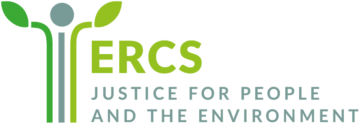This Voice for Justice comes from Mark, who was concerned about the environmental harm of a local quarry and its storage and processing of incinerator waste contaminating the adjacent forest.
Without the commitment and tenacity of Mark, other concerned residents and local Councillors, pollution controls would not be enforced, and environmental harms would be allowed to continue unchecked.
A forest for all
Cullaloe Forest, located in Fife, is owned by Forestry and Land Scotland. Residents from the surrounding villages use the Forest for recreation and connecting with nature.
Mark, a resident who was born in the nearby village of Hill of Beath, has visited the Forest for much of his life. When he was young, he strolled through the Forest and rode along the trails with his brother and friends.
“It’s the only place I’ve ever seen red squirrels chasing each other about the trees.”
After suffering personal loss and hardship later in life, Mark found comfort in reconnecting with nature, as many people do. He returned to the forest, visiting frequently, immersing himself in nature.
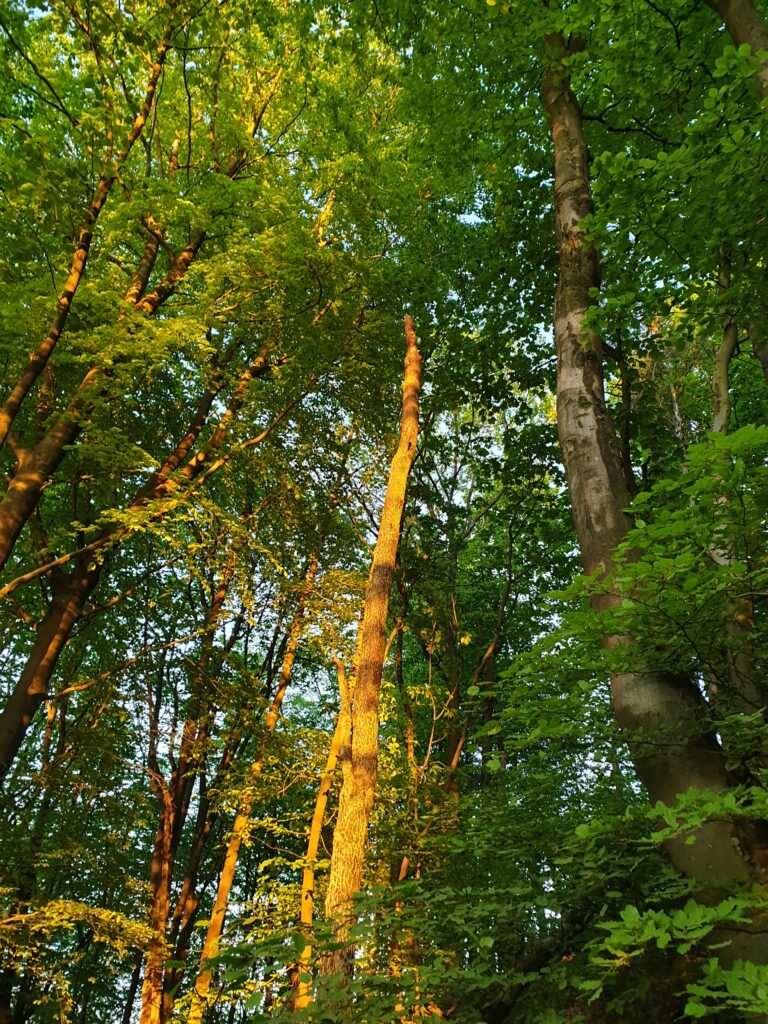
A quarry and toxic bottom ash
Goathill Quarry operates directly adjacent to Cullaloe Forest and was approved for extension in April 2023.[1] The quarry is operated by Collier Quarrying and Recycling Limited (‘Collier’).
In addition to quarrying activities, the quarry receives and processes waste from incinerators around Scotland. This waste is known as incinerator bottom ash, which contains considerable amounts of toxic chemicals and persistent organic pollutants which can leach out.[2] The bottom ash is processed onsite and combined with rock aggregate to produce construction and road surfacing materials.
The practice of using bottom ash in road and construction materials varies across the European Union, and regulations are fragmented. A review of research commissioned by Zero Waste Europe highlights significant concerns for public safety and the environment and recommends that, until further research is conducted, the use of bottom ash should be suspended.[3]
“I’m concerned that it’s being used in roads everywhere and will leach.”
There are no set methods to ‘clean’ bottom ash to prevent toxic chemicals from leaching into and contaminating the surrounding environment. Zero Waste Europe suggests that bottom ash as a construction material is exclusively driven by commercial interest hiding under the guise of a commitment to a circular economy.[4]
Environmental impacts on Cullaloe Forest from the Quarry
During Mark’s visits between 2023 and 2024, he recorded four key concerns.
- Dust from the quarry, potentially toxic incinerator bottom ash, was settling in the forest.
“The ash was all colours and grain sizes. On windy days, you can feel chunks against you in the Forest. There was a dusting on the plants and on the ground, it formed a slurry.”
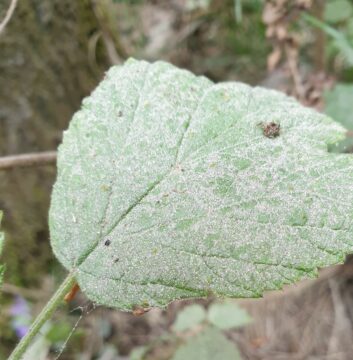
- The incinerator bottom ash at the quarry looked as though it was not being stored in a way that prevented toxic leachate from contaminating soil, groundwater and the nearby burns.
“Water’s running out the bottom of the ash and away into the countryside”
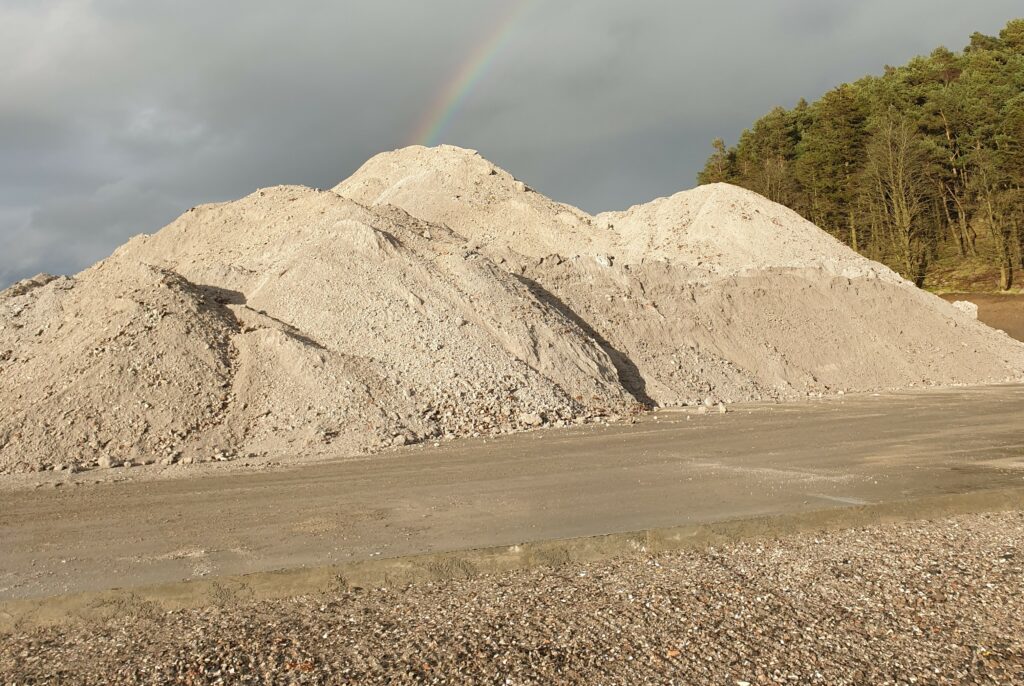
- In 2023, a portion of the forest was cleared as part of the quarry’s expansion, which residents thought would not be allowed.
Fife Council approved the extension of the quarry’s lifespan from the original closure date of 2025 to 2060.[5] As part of the extension, Forestry and Land Scotland leased a portion of Cullaloe Forest to the quarry.
“We thought it wasn’t going to go ahead because NatureScot did ecology surveys, which should have showed that these trees were home to red squirrels, badgers, bats and birds. When I was building mountain bike tracks up there, Forestry and Land Scotland were telling me that I shouldn’t cut a root or dig a hole or make features.”
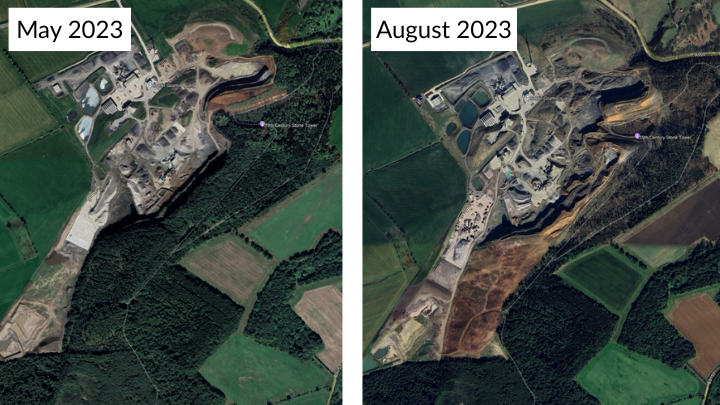
- Cottown Burn in Cullaloe Forest appeared to be dug up and was no longer flowing.
Fife Council granted planning permission to the quarry, subject to conditions.[6] Condition 13 of the planning permission requires that all watercourses in and adjacent to the quarry have to be kept clear of debris and maintained in a free-flowing condition. The dug up Cottown Burn seemed to be a breach of this condition.
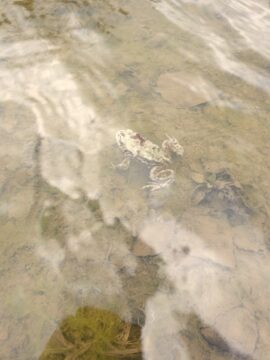
Seeking accountability
Concerned by the habitat destruction and pollution, Mark made complaints to the quarry owner, SEPA, Forestry and Land Scotland, NatureScot, Fife Council, local councillors and MSPs. His repeated complaints were noted in most cases, but he failed to see any tangible actions.
“I’m not an expert, I just know that it looks polluted, nasty and it stinks.”
Frustrated with the lack of accountability and action and knowing he could not stand back and watch the environment around the quarry be harmed, Mark contacted ERCS for help in 2023.
What followed was a long and complicated process of trying to get accurate information, accountability and a solution to Mark’s concerns.
2023: Legal advice and assistance from ERCS and further investigation
In March 2023, ERCS introduced Mark to planning conditions, pollution controls and how to object through the correct channels.
ERCS submitted Freedom of Information requests to SEPA and Fife Council to understand what enforcement action had been taken. Due to SEPA’s repeated failures to respond to freedom of information requests, ERCS had to make three separate appeals to the Scottish Information Commissioner. Following almost a year of correspondence, Mark received the information in February 2024 (a summary is provided at the end of this piece).
The quarry has a permit from SEPA under the Pollution Prevention and Control (Scotland) Regulations 2012.[7] That permit contains several conditions which regulate how the quarry operates. Mark discovered that in February 2023, SEPA found the quarry had breached eight conditions in the permit (the details of the 8 breaches are provided at the end of this piece).
Fife Council approved the expansion of the quarry two months later.
2024: Seeking greater action for the environmental harms
ERCS sought enforcement action from SEPA and Fife Council relating to the four environmental impacts identified by Mark, with the following outcomes.
- Dust from the quarry, potentially toxic incinerator bottom ash, was settling in the forest.
Condition 3.3.1 of the quarry’s Pollution Prevention and Control permit states:
“All emissions to atmosphere from the Permitted Installation shall be free from visible emissions of particulate matter and fallout of particulate matter beyond the Site Boundary”
SEPA investigated the noncompliance of this condition and highlighted it to Collier. SEPA said that Collier put in additional dust suppression measures.
Following further complaints about dust pollution, SEPA then stated that no further issues with dust were noted in their subsequent inspections, and the matter was resolved.
SEPA also notified ERCS that they will ‘update’ the dust condition 3.3.1 to the following:
“Dust from the authorised activities, which has a significant impact on the environment, people or property, must not be emitted beyond the boundary of the authorised place.”
The new dust condition is significantly less stringent and will permit the quarry to emit more dust pollution. Mark says that dust from the quarry continues to settle in the forest.
- The incinerator bottom ash onsite looked as though it was not being stored in a way that prevents toxic leachate from contaminating soil, groundwater and the nearby burns.
In March 2024, ERCS wrote to SEPA to request enforcement of the noncompliance that had been identified by SEPA in February 2023 and alleged additional breaches of the permit arising from leachate.
SEPA stated that all noncompliances identified in February 2023 had been addressed.
SEPA made changes to the permit, which took effect in June 2024. These included the following:
- There must be perimeter kerbing and a sealed drained system around the impermeable areas where incinerator bottom ash is stored. Stockpiles of incinerator bottom ash must not be within 2 metres of the storage perimeter.
- Stronger monitoring requirements for emissions to the water environment, including leachate.
- New monitoring and protection requirements for soil and groundwater from pollution.
SEPA had addressed the breaches and updated the permit to ensure better protection of the environment from pollution.
- In 2023, a portion of the forest was cleared as part of the quarry expansion, which residents thought would not be allowed.
Fife Council confirmed that the planning conditions permitted tree felling in an agreed area and that the conditions stipulated a pre-start survey check before tree felling to ensure the protection of potentially affected species.
Contrary to his observations of animal life in the forest, Mark was told that a wildlife survey had been carried out, and there were no threats to wildlife. Mark says he was shocked to see the forest being bulldozed during bird breeding season. It is a criminal offence to injure wild birds and interfere with their nests.[8] When he asked the tree fellers if they were aware of birds present in the trees and if he could see the pre-start survey, this request was refused. Mark again sent complaints to Forestry and Land Scotland, but no action was taken.
There was no acknowledgement or justification for the alleged tree felling during the breeding season and the potential loss of wildlife.
- Cottown Burn in Cullaloe Forest appeared to be dug up and was no longer flowing.
Together with the dug up burn, Fife Council investigated several complaints from other members of the public about the quarry and published an ‘enforcement report’ in September 2023. In this report, Fife Council stated the dug-up Cottown Burn was not a breach of the following planning condition 13:
“All water courses within or adjacent to the site, must be kept clear of debris and maintained in a free flowing condition at all times to the satisfaction of the Fife Council as Planning Authority.”
This conclusion was made without the Burn being inspected. In March 2024, ERCS wrote to Fife Council highlighting this omission and requesting them to enforce the planning condition.
The Council took four and a half months to respond. ERCS had to make a complaint about the unreasonable delay.
When they eventually responded, they admitted that the Burn had not been inspected, but they could not take any enforcement action because the dug up burn was outwith the quarry and therefore the condition was not enforceable. Fife Council stated they would continue “to explore the potential to resolve the planning enforcement case informally with the landowner.”
The dug-up Cottown Burn remains unaddressed.
After 4 years of seeking enforcement of the quarry’s planning conditions and facing a lack of accountability, only one of the four issues raised by Mark was addressed.
Voice for Justice: Continuing to fight for Cullaloe Forest
Mark is angry and exasperated that many of his complaints were dismissed by SEPA and Fife Council, rather than investigated. Without Mark’s tenacity, improvements to the quarry’s pollution control would not have happened.
Mark says he wants “truth and accountability.”
Despite the multiple challenges Mark has faced in trying to fight for Cullaloe Forest and the surrounding environment, he remains steadfast and continues to gather evidence, document incidents and lodge complaints.
Many thanks to Mark for his ongoing fight for Cullaloe Forest and for taking the time to talk to Cornell Hanxomphou, ERCS Rights Officer.
Written by Cornell Hanxomphou, Rights Officer, April 2025
Enforcement action taken in relation to Goathill Quarry – obtained from Freedom of Information requests
- February 2023: SEPA issued a noncompliance letter to the quarry for eight breaches of their Pollution Prevention and Control permit.
- April 2023: SEPA sent an email to Collier to follow up on the ongoing noncompliance with their permit.
- April 2023: Fife Council granted planning permission to expand the quarry.
- May 2023: David Torrance MSP questioned the quarry’s planning conditions, including the lack of storage requirements for incinerator bottom ash in regard to environmental protection. SEPA agreed that the wording of the conditions was lacking to ensure protection of the environment.[9]
- June 2023: SEPA again pushed the quarry for ongoing noncompliance with its permit. Internal emails within SEPA stated that the quarry would be a failing site under their old Compliance Assessment Scheme, which stopped in 2019.[10]
- July 2023: SEPA completed an ecology investigation of the nearby burns, which concluded that while the water quality was poor, there was no evidence of contamination from the quarry at the time.[11]
- August 2023: SEPA acknowledged and confirmed dust leaving the quarry and stated it would be dealt with through compliance monitoring.[12]
- September 2023: Following several complaints from other members of the public (quarry) and the MSP, Fife Council published an ‘enforcement report’ to respond to the following concerns:
- The dug-up Cottown Burn.
- Rock falls.
- Tree felling.
- Breach of the planning condition for the incinerator bottom ash stockpile to be stored below 6 meters in height.
- Unauthorised works to extend the concrete pad for incinerator bottom ash, and an additional settlement pond.
The report identified that items 1 to 3 were not a breach of planning conditions. Fife Council stated that item 4 was a breach of the planning conditions and would be highlighted to the quarry manager. Fife Council stated the unauthorised works in item 5 would require planning applications.[13]
Collier Goathill Quarry Pollution Prevention and Control permit noncompliance – February 2023
The following is a list of noncompliances with the conditions of Collier Goathill Quarry’s permit identified by SEPA in February 2023.
- Condition 1.1.1.2 describes the site boundary: Untreated incinerator bottom ash waste is being stored outside the site boundary
- Condition 2.3 requires the permitted installation to be operated in accordance with a written management system: No written management system is in place.
- Condition 2.5.1 and 2.5.2 require the results of all emissions monitoring to be reported to SEPA in writing by 31 January of the next year: No emissions to water reports were received by January 2022 or January 2023.
- Condition 2.8 requires a sampling plan for water and treated IBAA to be prepared and implemented within 6 months of the date of the permit, maintained, reviewed annually and reported to SEPA by 1 December each year: No sampling plans have been received by SEPA.
- Condition 4.3.3 requires incinerator bottom ash aggregate to be sampled according to a sample plan. No sampling plan was provided.
- Condition 5.2.4 requires annual inspection and assessment of all working surfaces, including photographs. No assessment has been received by SEPA.
- Condition 5.4.5 requires sampling and measurement of emissions to water from point W1 on a monthly basis and continuous monitoring of flow rate, conductivity and pH: Monthly sampling isn’t being done and no continuous monitoring is being done.




